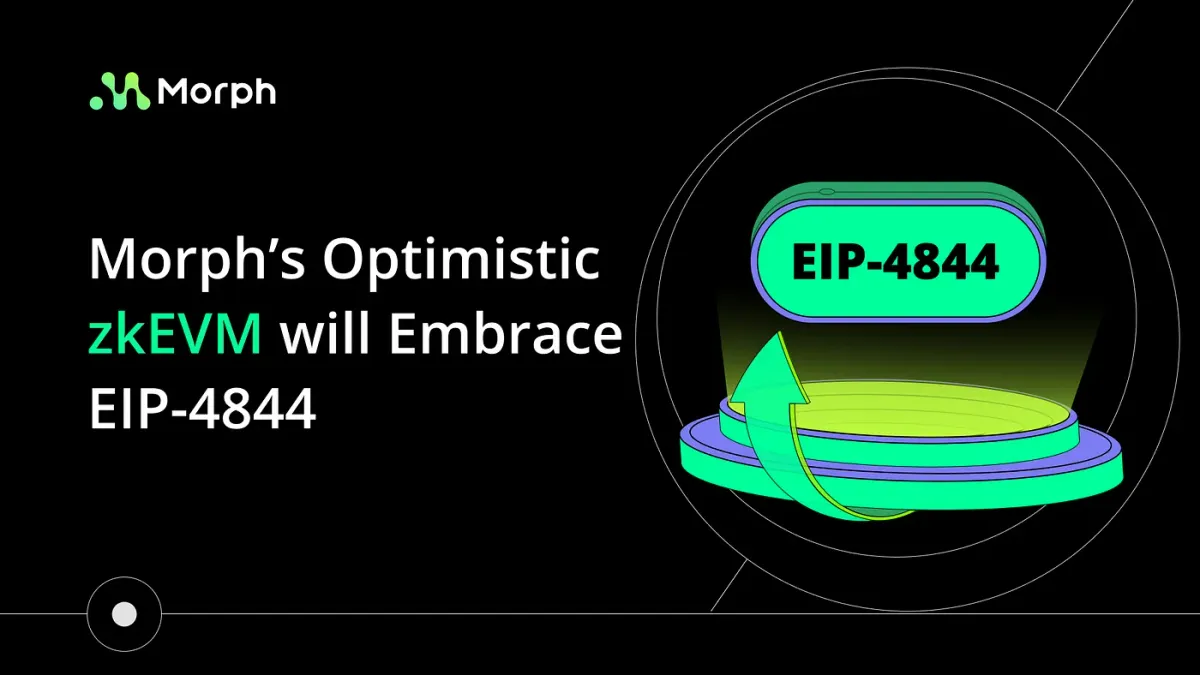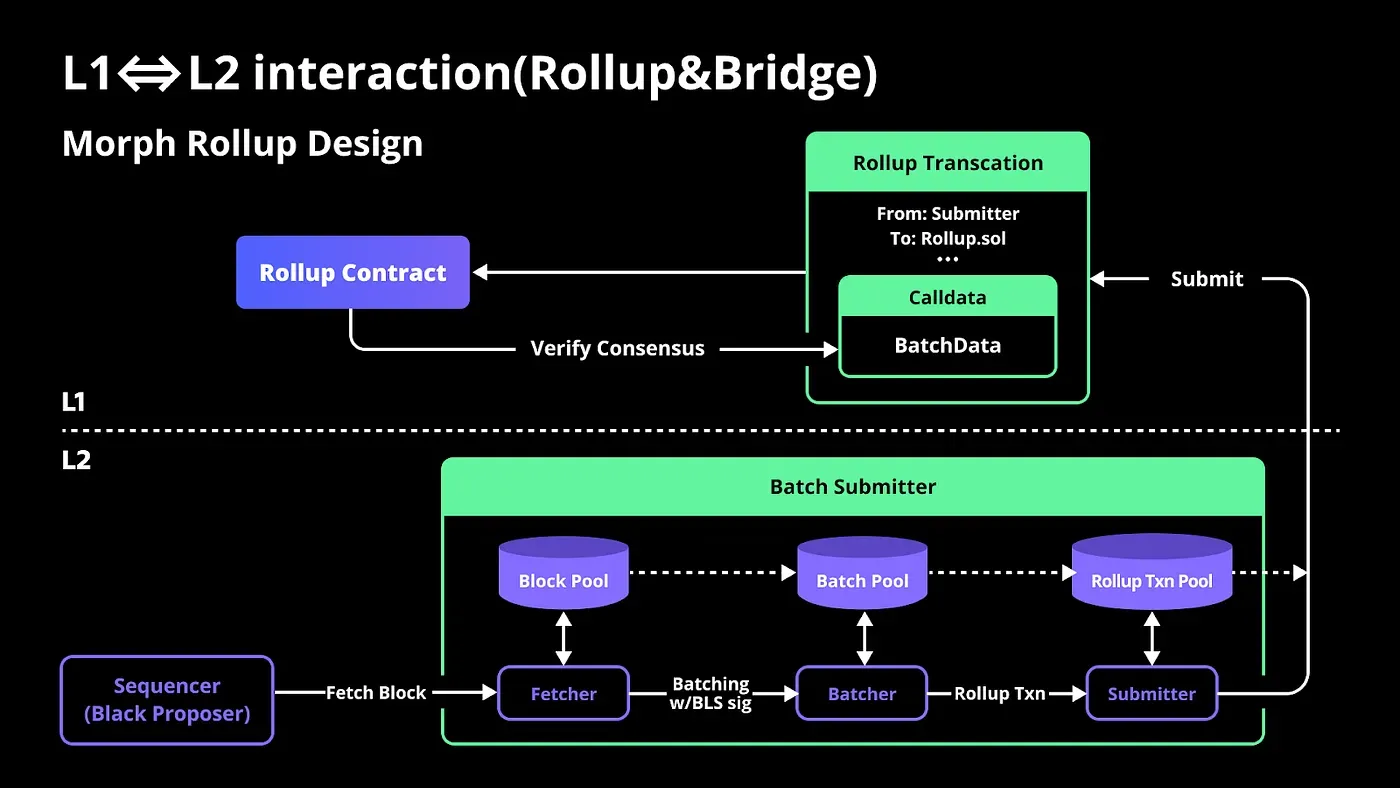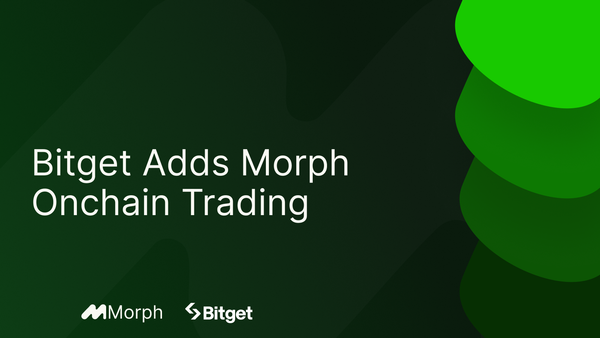Morph’s Optimistic zkEVM will Embrace EIP-4844

As we step into the latter half of February 2024, the Ethereum network is on the cusp of its most important upgrade yet — the Decun Upgrade. At the heart of this pivotal change lies EIP-4844, a development that is set to fundamentally redefine the economics of Layer 2 solutions on Ethereum.
EIP-4844: A Gateway to Efficiency
EIP-4844 introduces a groundbreaking Ethereum transaction structure known as “data blobs.” This innovation is poised to drastically lower operational costs for Ethereum-based Layer 2 networks. The ripple effect of this reduction will be felt directly by users in the form of significantly lower Gas Fees, thereby enhancing the Ethereum L2 experience significantly.
At Morph, our commitment to being a leader in blockchain technology has led us to monitor the developments surrounding the Ethereum mainnet’s upgrade closely. Our dedicated R&D efforts have positioned us to swiftly adapt to these advancements.
Morph’s Strategic Integration of EIP-4844
We are thrilled to announce that both our Holesky testnet and our eagerly anticipated mainnet launch in Q2 will feature EIP-4844 integration from the get-go. This strategic move ensures that our Layer 2 network will not only inherit Ethereum’s robust security framework but will also introduce unprecedented cost optimizations and speed enhancements from day one.
In the upcoming weeks, we will publish a detailed article explaining our process of incorporating EIP-4844 atop our innovative optimistic zkEVM framework. This integration is solid proof of our extensive work in cryptography and crypto-economic design, laying down a foundation that combines technical ingenuity with economic viability. Our future article aims to shed light on the profound significance and added value that EIP-4844 brings to both Ethereum and Morph. It’s designed to enlighten those new to these concepts, providing a clear understanding of why this upgrade is a game-changer for users and the broader blockchain ecosystem.
What is EIP-4844?
EIP-4844 introduces a new category of Ethereum transactions, known affectionately as “Blob-carrying transactions.” This innovative approach allows transaction senders to include arbitrary data within a “blob,” a dedicated space for storing information within the transaction itself.
The significance of this development cannot be overstated. By utilizing blob-carrying transactions, the cost associated with data storage on Ethereum is poised for a dramatic reduction. Traditional Ethereum transactions, while versatile, come with a higher data storage cost that can limit their use, especially in applications requiring the transfer of large amounts of data.
What Does This Mean For Layer 2 Solutions?
Understanding the role of EIP-4844 requires delving into the foundational principles of Ethereum’s Layer 2 (L2) networks. At its core, the essence of any Layer 2 solution revolves around its interaction with Ethereum’s main layer (L1). This relationship is not just structural but pivotal for inheriting Ethereum’s robust security features, a characteristic that defines the integrity of L2 solutions.
The Vital Role of Data Availability
A key aspect of this L1-L2 synergy is “Data Availability.” For an L2 solution to truly be considered a part of Ethereum’s extended ecosystem, it must regularly submit L2 data — including transactions and states — back to L1. This process ensures that L2 platforms maintain the same level of security and trust as Ethereum itself. However, this submission process, often referred to as “rollup,” has traditionally been both costly and limited by technical constraints.
Take Morph’s rollup process, for instance, as illustrated below. In our system, L2 blocks are batched together and submitted to Ethereum through a single transaction.

While effective, this method, like many others in the L2 space, faces challenges due to the high costs and limited space of storing data in Ethereum’s calldata — until now.

The Arrival of Blob Transactions
EIP-4844 introduces “blob-carrying transactions,” a game-changer for data storage and submission from L2 to L1. This new method allows for significantly more data to be stored at a fraction of the cost. Traditional storage methods in calldata not only incur higher expenses but also suffer from spatial limitations, given calldata was not originally designed for such extensive data storage.
With blobs, the equation changes dramatically. For example, where once storing 100 L2 transactions in calldata might cost 0.01 ETH, blobs enable the storage of 1,000 L2 transactions for just 0.001 ETH. This is not just a simple optimization but a true entire paradigm shift, reducing the cost of storing a single L2 transaction to just 1% of its previous amount.
This breakthrough has profound implications for gas fees on Layer 2 platforms. Traditionally, a significant portion of gas fees on L2 has been allocated to covering these L1 storage costs — up to 90% by some estimates. With EIP-4844, we’re looking at a future where the economic model of using L2 networks becomes far more favorable for users, enhancing accessibility, and fostering broader adoption of Ethereum’s Layer 2 solutions.
Looking Ahead: EIP-4844’s Integration and Morph’s Next Steps
Currently, EIP-4844 is undergoing rigorous testing on the Ethereum Holesky testnet, with the Ethereum community eagerly awaiting its deployment on the mainnet.
An upgrade of this magnitude requires a comprehensive adjustment of both L1 contracts and off-chain components to align with EIP-4844’s innovative data storage approach. At Morph, we’re active participants in this evolution. Our team is diligently working to adapt our infrastructure, ensuring that once EIP-4844 goes live on the mainnet, Morph will be fully prepared to leverage its benefits from day one.
While we’ve offered a glimpse into the transformative potential of EIP-4844, the intricacies of this upgrade in relation to Morph’s optimistic zkEVM design are more complex. Morph plans to release a series of in-depth articles exploring the nuances of EIP-4844’s integration. These pieces will not only delve into the technicalities but also highlight how Morph’s unique architecture optimizes these advancements for an unparalleled Layer 2 experience.
Stay tuned for more updates and deep dives into the world of Layer 2 innovation with Morph.
About Morph
Morph is a consumer Layer-2 blockchain. Combining the best of OP and ZK rollups, it offers unmatched scalability and security, aiming to lay a foundation for an ecosystem of consumer-focused, value-driven DApps.
Through its hallmark features, such as a Decentralized Sequencer Network, Responsive Validity Proof (RVP) system, and modular design, the project delivers efficient and flexible scaling while preserving the initial security, availability, and compatibility of the Ethereum network.




